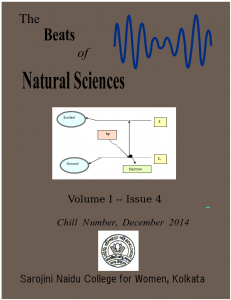ISSN 2348 – 7615
Volume I, Issue 4 Chill Number (December), 2014
From the Desk of the Editors:
The last issue (December issue) of the volume 1 of this journal is being published though with some delay due to certain technical glitches occurred – regarding processing of the selected articles and finally in internet network. It was scheduled to be available online from the winter solstice and we must apologise to the authors and the readers. This issue, like the previous ones, consists of the articles of different types and from different scientific disciplines. From the next volume (for 2015) we hope to provide article templates in .doc as well as in .tex format in our website and will request the authors to submit their materials using those, which may considerably reduce the processing time of the editorial team. The publication of the first issue of the next volume is slated to be published on the next vernal equinox.
The experience of publishing volume 1 was quite enriching with a wide response from scientific workers of different corners. The full list of articles with authors of that volume will be available separately when the full volume will be archived in the journal page. But we expect from the next volume to get submissions with more number of students’ projects and articles drafted in Bengali. So it is an open call for everyone to contribute more particularly in these sections. Wish everyone a very happy New Year!
Download pdf: From the Desk of the Editors
Brief reports of original research works:
- Mineral Assay in Atomic Absorption Spectroscopy
B.N. Paula, S. Chandaa, S. Dasa, P. Singha, B.K. Pandeya and S.S.Girib [dropdown_box expand_text=”Abstract” show_more=”View” show_less=”Hide” start=”hide”]Minerals are necessary for the health and maintenance of several human body functions like oxygen transportation, normalizing the nervous system and simulating growth, maintenance and repair of tissues and bones. Atomic Absorption Spectroscopy (AAS) is a very useful tool for determining the concentration of specific mineral in a sample. Liquefied sample is aspirated, aerolized and mixed with combustible gases such as acetylene and air or acetylene and nitrous oxide and burned in a flame to release the individual atoms. On absorbing UV light at specific wavelengths the ground state metal atoms in the sample are transitioned to higher state, thus reducing its intensity. The instrument measures the change in intensity and the intensity is converted into an absorbance related to the sample concentration by a computer based software.[/dropdown_box] Download Full Paper
Review on current frontiers or historical milestones:
- Diagonally Related Elements Ga, Sn and Bi in Pharmaceutical Applications
Sankar Prasad Paik [dropdown_box expand_text=”Abstract” show_more=”View” show_less=”Hide” start=”hide”]Metal complexes provide new opportunity for designing metal based pharmaceutical (metallodrug) industries with definite properties. The number of diseases and their treatment depend on the metabolism of inorganic constituents. The advancement in inorganic chemistry provides a golden opportunity to use metal complexes as therapeutic and diagnostic agents. The mode of action of metal complexes on living organism is different from non metals. The present article summarizes various pharmaceutical applications of some diagonally related trace metals (Ga, Sn, Bi) and their complexes. [/dropdown_box]Download Full Paper
- Kinetics of Enzyme Inhibition
Debjani Sur[dropdown_box expand_text=”Abstract” show_more=”View” show_less=”Hide” start=”hide”] Enzyme catalyzes virtually every biochemical process. Some kind of regulatory mechanisms exist within the cell to control enzyme catalyzed reactions. Generally the enzymes are modulated in the cell by low molecular weight inhibitors which may or may not be present at all times. Inhibitors also provide a means to study the functional groups at the active sites. For a better understanding of the emerging enzyme inhibitors which includes drugs, insecticides, antibiotics, poison etc. on enzyme mechanism, their study of kinetics is of great importance. [/dropdown_box]Download Full Paper
- Biology of Retipenna jubingensis (Hölzel) (Neuroptera: Chrysopidae) from Murshidabad, West Bengal
Santi Ranjan Dey[dropdown_box expand_text=”Abstract” show_more=”View” show_less=”Hide” start=”hide”] The family Chrysopidae (Neuroptera) includes many species that could be considered important biological control agents. The chrysopids, are studied for their obligate relationship with the aphids. Biology of chrysopid comprising the study of development, reproductive potential, larval consumption, rate of survival of the larvae and eggs and longevity of adult, helps in assessing the predatory efficiency. The biology of Retipenna jubingensis (Hölzel), an aphidophagous chrysopid, was studied from Murshidabad, West Bengal, India. The egg, larval, pupal description, their development, oviposition, fecundity and longivity of the adult were noted along with their predatory efficiency. At a relatively high average temperature (27 ± 2.1ºC) Retipenna jubingensis (Hölzel) found to be better predator than other chrysopids. [/dropdown_box]Download Full Paper
- Dwindling Treasures of the Rice Fields of West Bengal
Mitu De[dropdown_box expand_text=”Abstract” show_more=”View” show_less=”Hide” start=”hide”] Rice is one of the very few crop species endowed with rich genetic diversity. The genus Oryza has extensive intra-specific variation, differentiation into subspecies (sativa and japonica) and further differentiation into different cultivar groups as folk varieties, landraces, breeding lines, and modern varieties. More than natural selection, the selection imposed by farmers makes folk varieties or landraces significant with their social, cultural and religious ties in farming communities. These folk varieties, grown in subsistence agriculture, are diverse and generally carry a great amount of genetic variability in their populations. These genetic treasures are silently being eroded from our fields following the onslaught of the High Yielding Varieties (HYVs). [/dropdown_box]Download Full Paper
Contact Informations :
| Publisher: Principal, SAROJINI NAIDU COLLEGE FOR WOMEN |
Address: SAROJINI NAIDU COLLEGE FOR WOMEN,30, Jessore Road, Dumdum, Kolkata 700028, India | Phone No.: +91-33-2559 2583 email: info@sncwgs.ac.in |
| Editors: Dr. Sonali Saha Dr.Soma Aditya Bandyopadhyay Dr. Chaitali Biswas |
Address: SAROJINI NAIDU COLLEGE FOR WOMEN,30, Jessore Road, Dumdum, Kolkata 700028, India | Phone No.: +91-33-2559 2583 email:editors.bns@sncwgs.ac.in |
 Pay Your Fees
Pay Your Fees 



